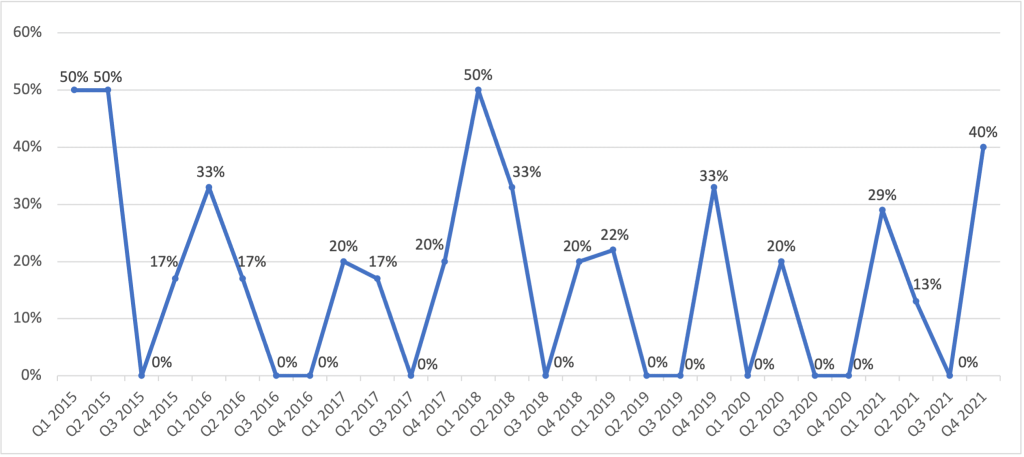Maybe it’s the cold. Maybe it’s the shorter days. Maybe it’s people not getting out as much. But something about this time of the year makes people want to curl up and listen to ballads.
As we head into this winter, Adele’s heart-wrenching ballad Easy On Me, which just logged its seventh week at #1 in December, is leading the Hot 100. Last winter, it was Olivia Rodrigo’s emotive ballad, Drivers License, that occupied the top spot for eight weeks starting in January 2021. And prior to that, ballads like Lose You To Love Me and Someone You Loved were enjoying peak popularity during the winter of early 2020.
The colder months (Q4 and Q1) have traditionally seen an increase in Hot 100 Top 10 hits with a ballad influence, along with peaks in early spring (late Q1/early Q2). Since 2015, the sole exception to this “rule” was the winter of early 2019, when ballad-influenced hits were on a downward trend; but even so, ballad-influenced mega-hits such as Without Me and Shallow were still topping the charts during this time.
In fact, an analysis of the top performing ballads since 2015 – those that reached the top 3 of the Hot 100 – shows that all but two charted during the colder months of each year.
Non-Hip Hop Hot 100 Top 3 Hits with a Ballad Influence
So, what does a hit wintertime ballad look like compositionally?
The following are some of the key commonalities shared between the 19 ballads that charted in the top 3 since 2015:
- Primary Genre: 74% were pop songs, followed distantly by R&B at 16% (Earned It, Stuck With U and Leave The Door Open) and rock and country with one song each (Take Me To Church and Meant To Be, respectively).
- Sub-Genres & Influences: The two most popular influences among ballads were R&B and singer-songwriter at 63% and 42% of songs, respectively. Interestingly, there was a clear shift around 2018 from R&B being the most popular influence to singer-songwriter.
- Vocals: Not surprisingly, all ballads during this time were exclusively sung. Of them, there was an even split between male and female vocals as the most popular with 37% each, followed by male/female duets with 26%. The latter includes duets by Taylor Swift and Zayn (I Don’t Wanna Live Forever), Ed Sheeran and Beyonce (Perfect), and Lady Gaga and Bradley Cooper (Shallow).
- Lyrics: Also not surprisingly, the majority of these songs had a love/relationships lyrical theme with 89%. Roughly half of them were about a breakup. Of the two songs that do not have a love/relationships theme, Pillowtalk has a hooking up theme and 7 Years discusses the ups and downs of getting older.
- Instruments: Ballads tend to feature more “traditional” instrumentation compared to their mainstream contemporaries. For instance, instruments like acoustic piano, strings, electric bass, acoustic drums and organ were, for the most part, more than twice as popular among ballads than overall non-hip hop hits. Conversely, electronic instruments like synths, synth bass and electronic drums were significantly less popular among ballads.
- Key & Tempo: 74% of ballad-influenced hits were in a major key, and not a single one has been in a minor key since 2019. In terms of tempo, not surprisingly, 84% landed at 79 BPM or less, with the most popular ranges being 60-69 BPM and 70-79 BPM. Only three songs were faster – Shallow, All Too Well and Love Me Like You Do, which land in the 90-99 BPM range.
- Song Length: In general, ballads tend to be longer than the average non-hip hop hit. From 2015 – 2018, the 4:00+ range was most popular for ballads. Since 2019, the average ballad length range shortened to 3:30 – 3:59. This is in line with the overall trend towards shorter song lengths in the mainstream at this time.
- Sections: In regard to the sections included in high-charting ballads, roughly two-thirds contain a pre-chorus; just over half contain a bridge, while the rest all contain a different “D” (departure) section such as an instrumental break or breakdown third verse; 89% begin with an intro; and just over two-thirds end with an outro.
All in all, the yearly rise and fall of the ballad is a great case-in-point about the importance of being in tune not only with compositional best practices, but also with seasonal trends to maximize a song’s exposure. So next time you feel a chill in the air, it just may be time to release your next ballad!
‘Tis the Season for Ballads Playlist
